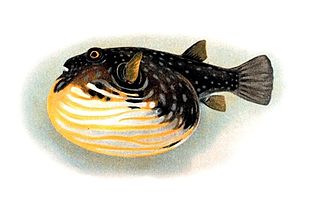
Tetraodontidae is a family of primarily marine and estuarine fish of the order Tetraodontiformes. The family includes many familiar species variously called pufferfish, puffers, balloonfish, blowfish, blowers, blowies, bubblefish, globefish, swellfish, toadfish, toadies, toadle, honey toads, sugar toads, and sea squab. They are morphologically similar to the closely related porcupinefish, which have large external spines. The scientific name refers to the four large teeth, fused into an upper and lower plate, which are used for crushing the hard shells of crustaceans and mollusks, their natural prey.

The striped burrfish or simply burrfish is a member of the porcupinefish family Diodontidae.

The Lessepsian migration is the migration of marine species along the Suez Canal, usually from the Red Sea to the Mediterranean Sea, and more rarely in the opposite direction. When the canal was completed in 1869, fish, crustaceans, mollusks, and other marine animals and plants were exposed to an artificial passage between the two naturally separate bodies of water, and cross-contamination was made possible between formerly isolated ecosystems. The phenomenon is still occurring today. It is named after Ferdinand de Lesseps, the French diplomat in charge of the canal's construction.

The deepwater burrfish is a porcupinefish of the family Diodontidae, found off southern Australia, central and northern New Zealand, and in the Tasman Sea. It occurs at depths of 40 to 270 m in areas off the continental shelf. The species reaches 50 cm in total length and is reportedly easily entangled in nets due to its spines and ability to inflate its body. It is the only known member of its genus.

The grey triggerfish, or gray triggerfish, is a species of ray-finned fish in the triggerfish family. The species is native to shallow parts of the western Atlantic from Nova Scotia to Argentina and also the eastern Atlantic, the Mediterranean Sea and off Angola on the west coast of Africa.

The spiny red gurnard is a species of marine ray-finned fish belonging to the family Triglidae, the gurnards and sea robins. This species is found in the northwestern Pacific Ocean where they occur at depths of from 25 to 615 metres. This species grows to a length of 40 centimetres (16 in) TL. This species is of commercial importance as a food fish.

Chilomycterus antillarum, the web burrfish, spiny box puffer, bridled burrfish or striped burrfish, is a species of fish in the family Diodontidae native to the Western Atlantic Ocean, southern Florida, and the Bahamas to Brazil. The species can grow up to 12 inches in length.

Chilomycterus antennatus, the bridled burrfish, is a species of fish belonging to the family Diodontidae. It is native to the tropical waters of the Western Atlantic from southeastern Florida and the Bahamas to northern South America. They are also found in the Eastern Atlantic off the cost of Mauritania.
Saltwater fish, also called marine fish or sea fish, are fish that live in seawater. Saltwater fish can swim and live alone or in a large group called a school.

Chilomycterus is a genus of diodontid tetraodontiform fishes commonly called "burrfish."

Chilomycterus reticulatus, the spotfin burrfish, spotted burrfish, Pacific burrfish, spotfin porcupinefish or few-spined porcupinefish, is a species of fish in the genus Chilomycterus, which is part of the porcupinefish family Diodontidae.

Eumicrotremus is a genus of lumpfishes native to the northern oceans. The name for this genus comes from the Greek roots eu meaning "good", mikros meaning "small" or "little", and trema meaning "hole".

Cottunculus is a genus of marine ray-finned fish belonging to the family Psychrolutidae. These fishes are found in the Atlantic, Pacific and Arctic oceans.

Cyclichthys orbicularis, known commonly as the birdbeak burrfish among other vernacular names, is a species of marine fish in the family Diodontidae.

The fauna of the United States Virgin Islands consists of 144 species of birds, 22 species of mammals, 302 species of fish and 7 species of amphibians. The wildlife of the U.S.V.I. includes numerous endemic species of tropical birds, fish, and land reptiles as well as sea mammals. The only endemic land mammals are six species of native bats: the greater bulldog bat, Antillean fruit-eating bat, red fruit bat, Brazilian free-tailed bat, velvety free-tailed bat and the Jamaican fruit bat. Some of the nonnative land mammals roaming the islands are the white-tailed deer, small Asian mongoose, goats, feral donkeys, rats, mice, sheep, hogs, dogs and cats.

Eumicrotremus spinosus, commonly known as the Atlantic spiny lumpsucker, is a species of lumpfish native to the Arctic and North Atlantic.
Chilomycterus mauretanicus, commonly known as the Guinean burrfish, is a species of burrfish in the family Diodontidae. It is native to the eastern Atlantic Ocean, where it ranges from the Canary Islands to Angola, as well as possibly Namibia. It is typically seen in environments at depths of less than 100 m with a substrate composed primarily of sand or mud. The species reaches 25 cm in total length and is known to feed on hard-shelled invertebrates such as mollusks. Although the toxicity of the species has not been confirmed, it is believed to be poisonous to humans. As such, it is not a target for commercial fisheries, and sale of the species is reportedly banned in some countries.
Cyclichthys hardenbergi, commonly known as Hardenburg's burrfish, is a species of porcupinefish in the family Diodontidae. It is native to the tropical western Pacific Ocean, where it is known from southern New Guinea and northern Australia east of Cape York. The species is typically seen at depths of less than 100 m (328 ft) over soft substrates. It is believed to be a solitary species that feeds on hard-shelled invertebrates. The species reaches 25 cm in standard length. Although sometimes caught by trawling, it is not a target for commercial fisheries.















